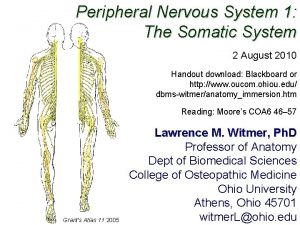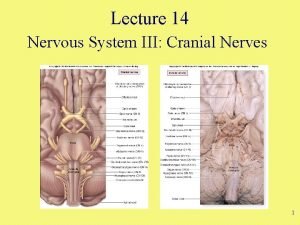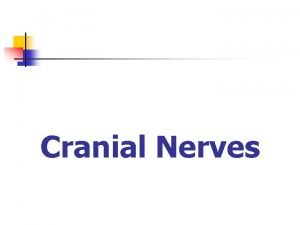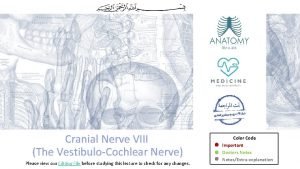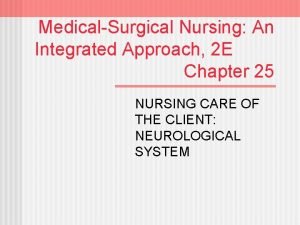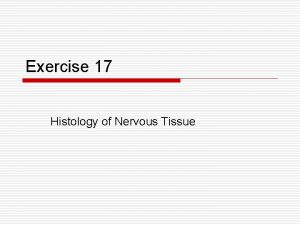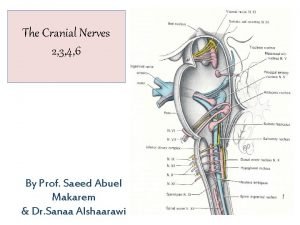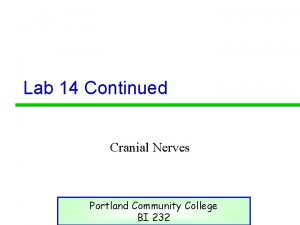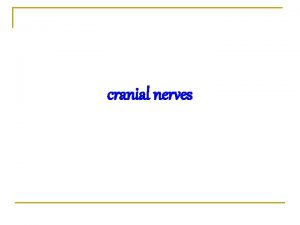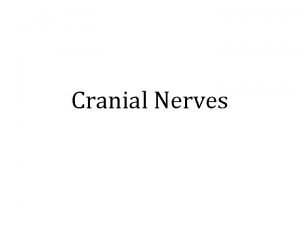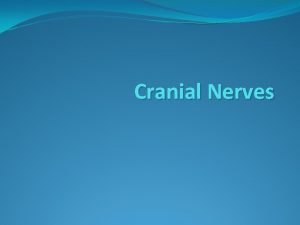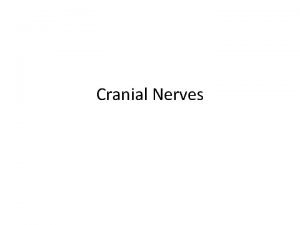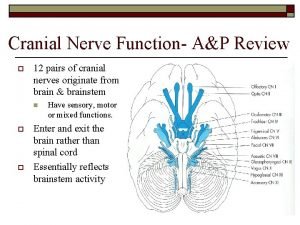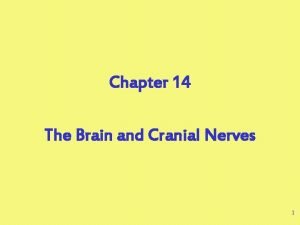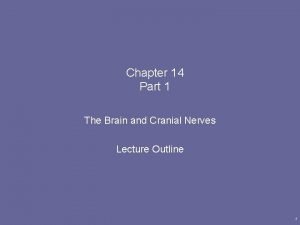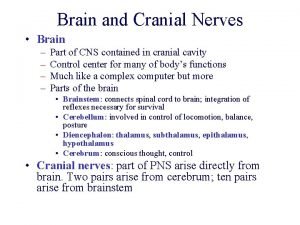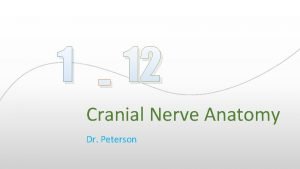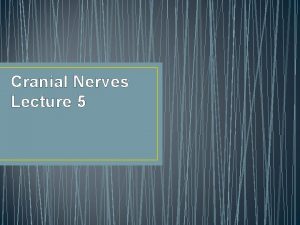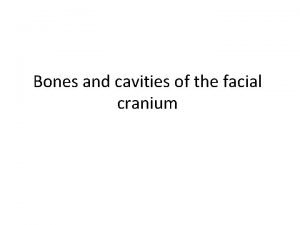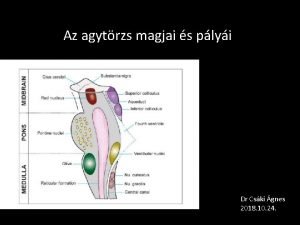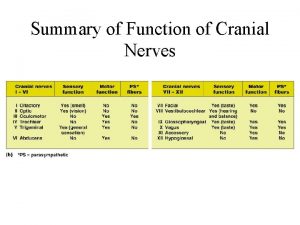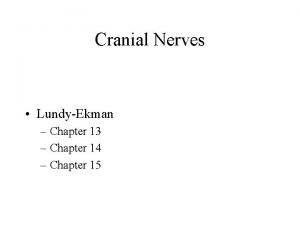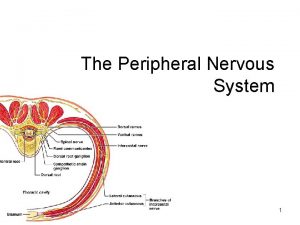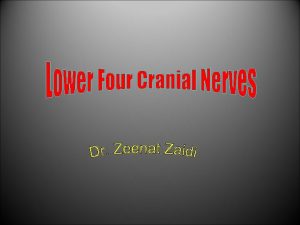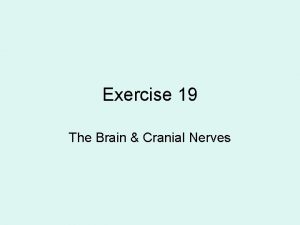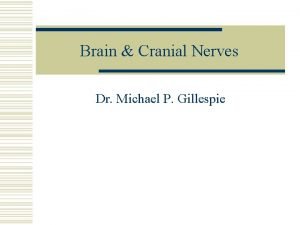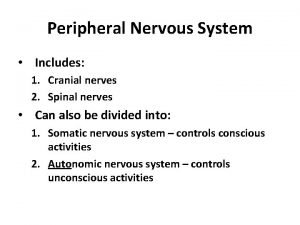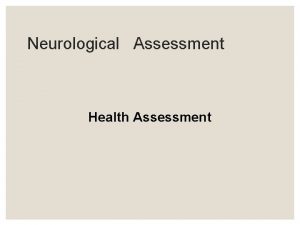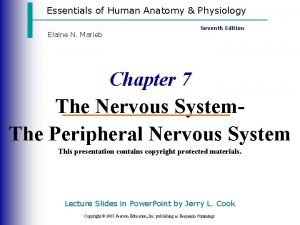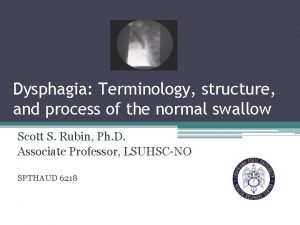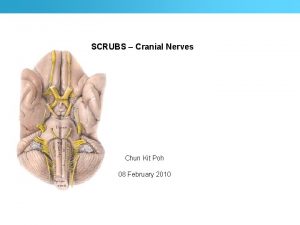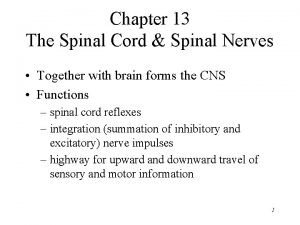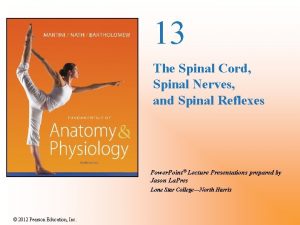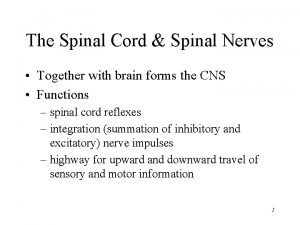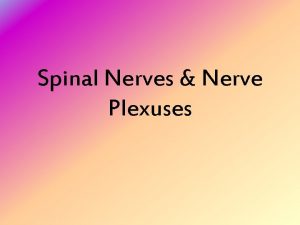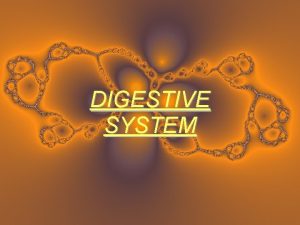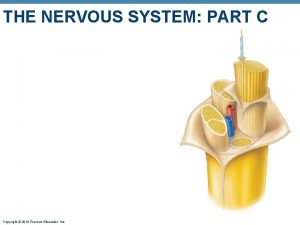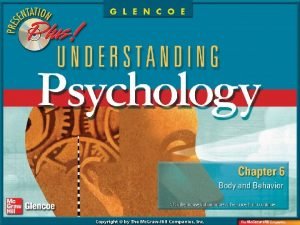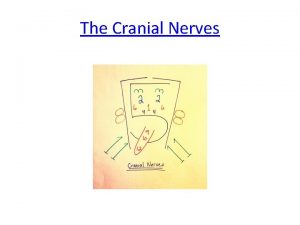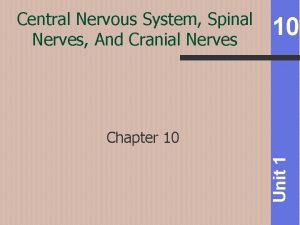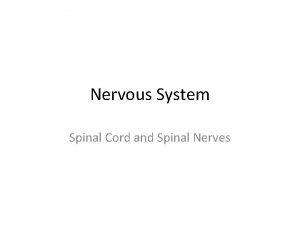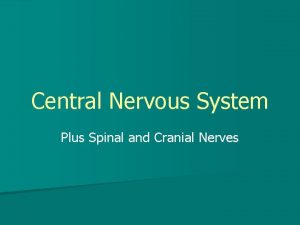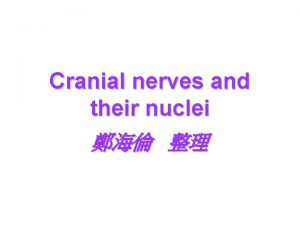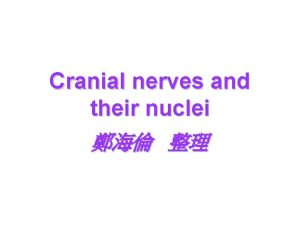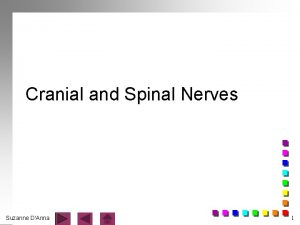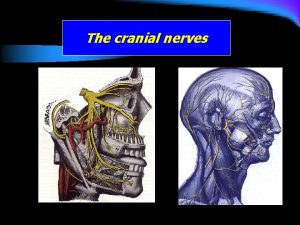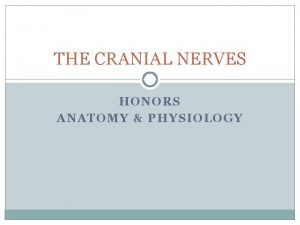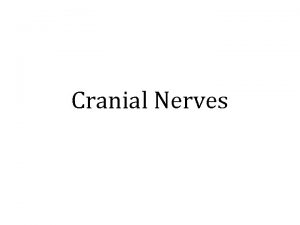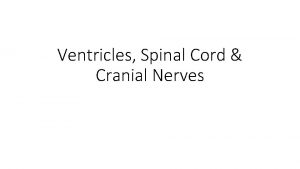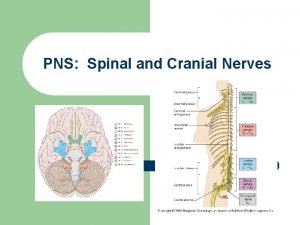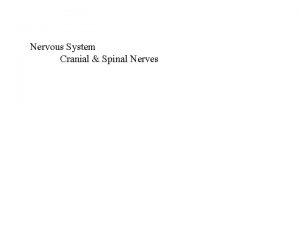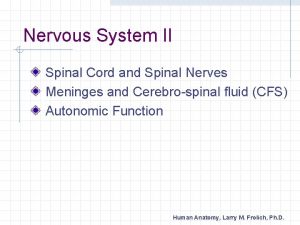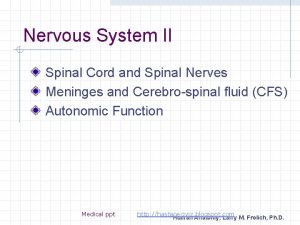Central Nervous System Spinal Nerves And Cranial Nerves

























































- Slides: 57

Central Nervous System, Spinal Nerves, And Cranial Nerves 10 Unit 1 Chapter 10

Spinal Cord Structure Protection and Coverings 10 • Spinal cord in vertebral cavity. Surrounded by bone • Wrapped in meninges • Spinal cord meninges are continuous with brain meninges Unit 1 3 layers of connective tissue

Spinal Meninges 10 • Epidural space lined with fat • Dura mater- tough , dense connective tissue Extends to 2 nd sacral vertebra Well beyond spinal cord • Arachnoid mater- collagen and elastic fibers • Subarachnoid space • Pia mater- transparent layer adheres to surface of brain & spinal cord Contains blood vessels Unit 1 cerebral spinal fluid circulates in this space

Figure 10. 1

• runs to 2 nd lumbar vertebra • Roots of spinal nerves for lumbar, sacral & coccygeal nerves in vertebral cavity before leaving = Cauda Equina • Enlargements: cervical & lumbar Include nerves for upper & lower limbs • Each spinal segment gives rise to a spinal nerve – 31 pairs 10 Unit 1 Gross Anatomy Of Spinal Cord

Figure 10. 2

Internal Structure Of Spinal Cord 10 • Two grooves- left & right halves Anterior median fissure & posterior median sulcus • Gray matter- 3 horns on each side • Anterior- somatic motor neurons • Posterior- sensory neurons • Lateral- autonomic motor Unit 1 Anterior, posterior, lateral

Internal Structure Of Spinal Cord (cont) 10 • White matter- organized into columns Anterior, posterior & lateral white columns Carry information toward brain • Motor = descending tracts Carry information down spinal cord Unit 1 • Each column contains one or more tracts having a common destination • Sensory = ascending tracts

Figure 10. 3

Spinal Nerves 10 Contains Cell bodies of sensory neurons • Ventral root- axons of somatic & autonomic motor neurons Unit 1 • Serve particular area of body • Contain 2 bundles of axons = roots • Dorsal root- only sensory axons • Swelling called dorsal root ganglion

• Named and numbered according to level of vertebra they emerge from • C 1 -8, T 1 -12, L 1 -5, S 1 -5 & 1 coccygeal • C 1 from above atlas • Rest through intervertebral foramina 10 Unit 1 Spinal Nerves (cont)

• Roots unite to form nerve at foramina • Mixed sensory & motor axons • Each axon wrapped in endoneurium • Axons grouped in fascicles wrapped in perineurium • Outer covering = epineurium 10 Unit 1 Spinal Nerve Composition

Figure 10. 4

• After leaving vertebra nerves branch • Some join with axons from neighboring nerves to form plexuses • Names then relate to area they are in or region innervated • Spinal nerves T 2 -T 11 do not form plexuses= intercostal nerves Supply abdominal muscles, skin of chest & back and muscles between robs. 10 Unit 1 Distribution Of Spinal Nerves

Plexuses 10 e. g. ilioinguinal, femoral, obdurator nerves • Sacral plexus- buttocks, perineum & lower limbs e. g. Gluteal, sciatic & pudendal nerves Unit 1 • Cervical plexus- posterior head, neck, shoulders & diaphragm • Brachial plexus-upper limbs & some neck & shoulder muscles • Lumbar plexus- abdominal wall, external genitals & part of lower limbs

Figure 10. 2

• Routes signals along pathways • Gray matter integrates signals • Reflex = fast involuntary sequence of actions in response to a stimulus • Inborn reflex e. g. withdrawal reflex • Can also have learned reflexes, e. g. driving skills • Can be spinal or cranial integration 10 Unit 1 Spinal Cord Functions

Reflex arc (patellar reflex) 10 1. Sensory receptor- responds to stimulus Tap below patella 2. Sensory neuron- to dorsal horn & brain 3. Integrating center- e. g. single synapse 4. Motor neuron- from center to effector Via ventral horn 5. Effector- responder (muscle or gland) Patellar reflex- rectus femoris contracts Unit 1 Sensory to motor neurons

Figure 10. 5

Brain-major parts 10 • Brain stem- continuous with spinal cord Medulla oblongata, pons, midbrain • Diencephalon- above brain stem Thalamus, hypothalamus & pineal gland • Cerebrum- at top and largest part • Cerebellum- back of brain stem Means “little brain” • Cranial meninges- dura mater, arachnoid mater & pia mater Unit 1 Surface covered with gray matter- cortex Beneath is cerebral white matter

Figure 10. 6 a

Figure 10. 6 b

Brain blood supply 10 • Requires ~20% body’s oxygen supply 4 min lack => permanent damage Allows lipid soluble materials: O 2, CO 2, alcohol, anesthetic agents but controls entry of other materials • Created by tight capillaries and glial cells Unit 1 • Requires continuous glucose supply • Protected by Blood-brain barrier

Cerebral Spinal Fluid (CSF) 10 • Circulates through ventricles of brain and the subarachnoid space. • 4 ventricles: 2 lateral, third & fourth • Formed in choroid plexuses • Flows through ventricles then from 4 th to central canal of spinal cord & subarachnoid cells Reabsorbed through arachnoid villi into superior saggital sinus Unit 1 = Specialized capillary networks in wall of ventricles covered by ependymal cells

Figure 10. 7

Brain Stem- Medulla 10 • Medulla Oblongata- inferior part of brainstem white matter extending between spinal cord & other parts of brain • several nuclei: cardiovascular center • Medullary rhythmicity area (respiratory rhythm) • Other sensory & reflex motor areas Some related to cranial nerves Unit 1 (heart rate)

Brain Stem- Pons 10 • Pons (bridge)- nuclei & tracts • Ascending & descending tracts • Nuclei – motor relays from cerebrum to cerebellum , respiration & cranial nerves V, VII, VIII Unit 1 Connect left & right of cerebellum

Figure 10. 8

Brain Stem- Midbrain 10 • Connects pons to Diencephalon • Nuclei = substantia nigra, red nuclei, cranial nerves III & IV • Superior colliculi – nuclei involved in tracking visual stimuli • Inferior colliculi – auditory input & startle reflex Unit 1 Large tracts = cerebral peduncles (motor)

• Netlike arrangement of gray and white mater • Ascending part = Reticular Activating System (RAS) • Projects to cerebral cortex & helps maintain consciousness • Inactivation => sleep 10 Unit 1 Reticular formation

Figure 10. 9

Diencephalon 10 • Thalamus- critical relay for sensory input Transmits motor information from cerebellum & basal nuclei to cerebrum Control of ANS-regulation of many activities Control of pituitary and hormone production Regulation of emotional & behavior patterns Regulation of eating & drinking Control of body temperature Regulation of circadian rhythms & states of consciousness Unit 1 • Hypothalamus- important for homeostasis

Figure 10. 10

Cerebellum 10 • Two cerebellar hemispheres • Cerebellar cortex –gray matter • Tree like white matter & nuclei • Attached to brain stem via cerebellar peduncles Unit 1 Posterior to medulla and pons, below cerebrum

• Gets wide range of sensory input • Compares with programmed motor activity from cerebral cortex • Smoothes & coordinates complex activities • Regulates posture & balance • Required for skilled motor activities 10 Unit 1 Cerebellar function

• Cerebral cortex • Internal white mater • Deep gray nuclei • Surface folds = gyri • Grooves between = sulci • Longitudinal Fissure- divides it into left & right hemispheres • Connected by corpus collosum 10 Unit 1 Cerebrum- Structure

Cerebrum- Structure (cont) 10 • Each hemisphere has 4 lobes Frontal, parietal, temporal, occipital Precentral gyrus anterior to sulcus= primary motor area Postcentral gyrus = primary sensory area • Deep gray = basal nuclei (basal ganglia) Globus palladus, putamen, caudate nucleus Unit 1 • Central sulcus separates frontal & parietal

Figure 10. 11 a

Figure 10. 11 b

• Ring of structures on inner border of cerebrum and floor of diencephalon • “emotional brain” – pain , pleasure, anger, affection, docility • Involuntary activity related to survival • Important in memory development 10 Unit 1 Limbic System

Figure 10. 12

• Specialized areas anatomically located • Sensory areas receive input and responsible for perception • Motor areas- initiate movements • Associative areas- complex integration: e. g. memory, emotion, reasoning, etc. 10 Unit 1 Function areas of Cortex

Sensory Areas 10 • Primary somatosensory areapostcentral gyrus. • Primary visual area- occipital lobe • Primary auditory area- temporal lobe • Primary gustatory area – base of postcentral gyrus • Primary olfactory area- medial aspect of temporal lobe Unit 1 input includes: touch, proprioception, pain, itching, tickle, temperature

Motor Areas 10 interacts with premotor area & primary motor area to regulate breathing and speech muscles Unit 1 • Mainly from anterior part of hemisphere • Primary motor area- precentral gyrus • Broca’s speech area-

Association Areas 10 Posterior to primary somatosensory area Integrates sensation- exact shape & texture of object compares with stored memories • Wernike’s area- left temporal & parietal lobes Interprets meaning of speech Right hemisphere adds emotional content Unit 1 • Adjacent to sensory & motor areas • connected with tracts- interpret information • E. g. somatosensory association area

Figure 10. 13

Sensory Pathways 10 Fine touch- body location, texture, size Proprioception- position & motion of body parts Vibratory sensations- fluctuating touch stimuli Unit 1 • Relay information from periphery to cerebral cortex • 3 neurons in each pathway. • Posterior column- medial lemniscus pathway

Figure 10. 14 a

• Spinothalamic pathways • anterior & lateral spinothalamic tracts • Relay impulses for pain, tickle, itch & thermal sensations. 10 Unit 1 Sensory Pathways (cont)

Somatic Motor Pathways 10 Local interneurons- e. g. reflexes Upper motor neurons- corticospinal tracts Basal ganglia- help with muscle tone Cerebellum- coordination Unit 1 • Signals converge on lower motor neurons • Lower motor neurons stimulate muscles directly • Input comes from:

Figure 10. 15

• Left gets input from & sends output to right side of body and vice versa • Left important for spoken & written language, numerical & scientific skills & reasoning • Right more involved with spatial and pattern recognition and emotional content 10 Unit 1 Lateralization

• Process for storing & retrieving information • Involves structural & functional changes • Involves association areas, parts of limbic system & diencephalon • Skill memory also involves cerebellum & basal ganglia 10 Unit 1 Memory

Cranial Nerves (table 10. 2) • • • I II IV V 10 Olfactory- special sensory optic- special sensory -eye oculomotor-Motor eye trochlear- motor eye trigeminal- Mixed • VI abducens- motor eye • VII facial- mixed sensory to front of tongue & motor to facial expression, lacrimal and some salivary glands Unit 1 sensory around eyes & upper mouth motor to chewing

Cranial Nerves 10 • VIII vestibulocochlear- special senses- ear • IX glossopharyngeal-mixed Sensory for rest of tongue, pharynx & palate, blood pressure Motor to pharyngeal muscles, parotid salivary gland Sensory from pharynx, ear, diaphragm, visceral organs in ventral cavity Motor to palatal & pharyngeal muscles & organs in ventral cavity Unit 1 • X vagus-mixed (major visceral nerve)

Cranial Nerves (Cont. ) 10 Unit 1 • XI Accessory-Motor to voluntary muscles including sternocleidomastoid and trapezius • XII hypoglossal. - motor to tongue

• Rapid growth during first few years • Size of neurons & proliferation of neuroglia • Increases development of dendritic branches & synaptic contacts • Decline in brain mass from early adulthood on 10 Unit 1 Aging
 Cns
Cns Spinal nerves labled
Spinal nerves labled Median nerve innervates
Median nerve innervates Spinal cord structure
Spinal cord structure Dermatome map
Dermatome map Which neuron is rare
Which neuron is rare Sensory input and motor output
Sensory input and motor output Processes of nerve cell
Processes of nerve cell First and second cranial nerves
First and second cranial nerves Old opie cranial nerves
Old opie cranial nerves Cn 3 nerve
Cn 3 nerve First and second cranial nerves
First and second cranial nerves Cranial nerves sensory and motor
Cranial nerves sensory and motor Glossopharyngeal nerve
Glossopharyngeal nerve Brachioradialis reflex nerve root
Brachioradialis reflex nerve root Exercise 15 histology of nervous tissue
Exercise 15 histology of nervous tissue Spinal cord and spinal meninges
Spinal cord and spinal meninges Oculomotor nerve
Oculomotor nerve Glossopharyngeal nerve examination
Glossopharyngeal nerve examination Afferent cranial nerves
Afferent cranial nerves The cranial nerves labeled
The cranial nerves labeled Cranial nerves
Cranial nerves Olfactory nerve
Olfactory nerve Some say money matters cranial nerves
Some say money matters cranial nerves Cranial nerves smile
Cranial nerves smile Cranial nerves labeled with roman numerals
Cranial nerves labeled with roman numerals Figure 14-2 cranial nerves labeled
Figure 14-2 cranial nerves labeled Crossed extensor reflex
Crossed extensor reflex Cranial nerve 11
Cranial nerve 11 Folyos
Folyos On old olympus towering tops
On old olympus towering tops Mandible landmarks
Mandible landmarks Nucleus ruber neurotransmitter
Nucleus ruber neurotransmitter Cranial nerves
Cranial nerves Ipsilateral cranial nerves
Ipsilateral cranial nerves Edinger westphal nucleus
Edinger westphal nucleus Saphenous nerve plexus
Saphenous nerve plexus Cranial nerves
Cranial nerves Cranial nerves
Cranial nerves Cn iiiv - vestibulocochlear nerve
Cn iiiv - vestibulocochlear nerve Cranial fossa nerves
Cranial fossa nerves Cranial nerve mnemonic
Cranial nerve mnemonic Cranial nerves
Cranial nerves Cranial nerve number face
Cranial nerve number face Dysphagia terminology
Dysphagia terminology Cranial nerves
Cranial nerves Function of spinal cord ppt
Function of spinal cord ppt Sacral plexus
Sacral plexus Nerve plexus
Nerve plexus Babinski sign
Babinski sign Spinal nerves
Spinal nerves The spinal nerves
The spinal nerves Spinal cord grooves
Spinal cord grooves Frog spinal nerves
Frog spinal nerves Spinal nerves
Spinal nerves Nervous system parts
Nervous system parts Nerves branching beyond the spinal cord into the body
Nerves branching beyond the spinal cord into the body Nervous system major divisions
Nervous system major divisions




